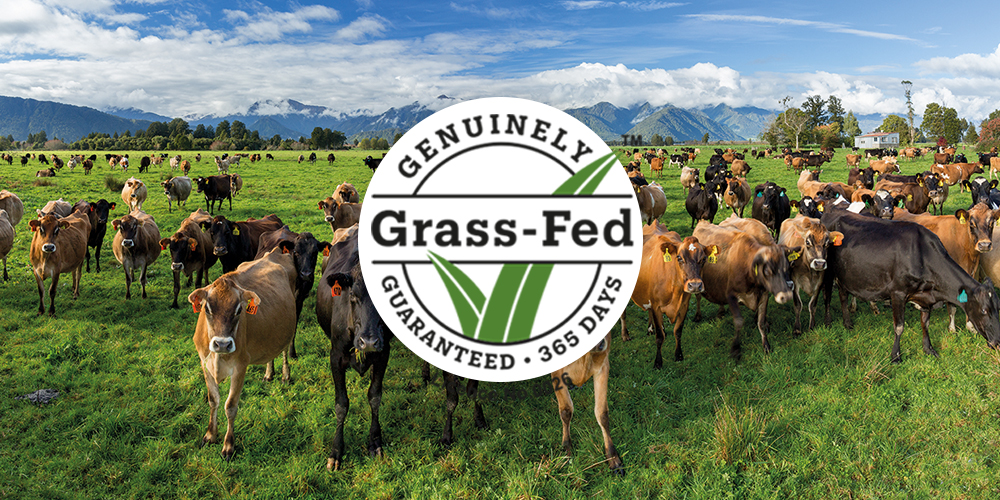
Congrats!!!
We acquired the Grass-Fed mark on all Hi Well colostrum products!
We are so happy to support your healthy lifestyle by providing high-quality daily supplements that can easily add to your healthy daily routine.
Proudly, all our colostrum products are made from 100% premium grade New Zealand bovine grass-fed colostrum collected from pasture-fed cows, promptly after calving. Please find all the information on why Grass-fed colostrum is a beneficial and high-quality health supplement in this blog.
The Grass-Fed Difference

Only around 10% of the milk produced across the world comes from cows that graze grass.
Why is this unique?
There are other companies that provide a Grass-Fed claim, but none that survey 100% of their milk suppliers annually and can claim that their milk comes from cows that graze free range 365 days of the year and have a diet of >95% grass-fed forage.
From Southern Alps of New Zealand
Hi Well products are produced, processed and prepared exclusively in a small geographical area beneath the Southern Alps of New Zealand’s South Island.
It is abundant in lush, fast-growing pastures. It is ideal free-range grazing land.
Hi Well’s distinctive flavour, texture and colour is unique to this environment and we believe it simply can’t be created anywhere else in New Zealand or around the world.

Grass-Fed explained
The cream and milk that we use to create our products are sourced from dairy farms that operate on a pastoral (grass-fed) basis.
This means that all dairy cows have daily access to pasture all year-round.
Through the winter as grass growth slows, the herd is fed on a range of natural crops, such as kale or rape, and grass silage; grass that is mowed, baled and preserved as silage in spring when grass growth exceeds requirements. This ensures cows maintain a full, well-rounded diet.

Defines ‘grass-fed’ forage as consisting of:
• Grasses and other pasture species, i.e.pasture monocots and broadleaf species, including but not limited to, clover, lucerne and plantain;
• Fodder and cereal crops (milky stage), for example swedes, rape, kale, turnips, fodder beet and similar species;
• Grass silage, hay, baleage, whole crop silage and the proportion of these in a feed mix;
• Other vegetative species that stock may eat while grazing.
Benefits of milk from grass-fed cows
High quality
Milk from grass-fed, free-range cows is of a high quality and provides a natural, rich taste.
Milk from grass-fed, free-range cows is of high quality and provides the natural richness of taste that Westpro’s Grass-Fed range is renowned for.
Taste better & More nutritious
Studies show that dairy products made from the milk of grass-fed, free-range cows not only taste better but are also more nutritious than milk produced by cows that don’t graze grass and/or have a high proportion of cereal and grains in their diet.
Less saturated fatty acids & More unsaturated fatty acids
An Austrian study showed that cows raised entirely on grass and alpine pastures produce milk with less saturated fatty acids and more unsaturated fatty acids than milk from intensively farmed cows.
Have a higher proportion of conjugated linoleic acid (CLA)
Grass-fed cows also have a higher proportion of conjugated linoleic acid (CLA) in their milk, which has been shown to have lots of beneficial effects on human health.
CLA reduces :
- body fat
- lowers the risk of cardiovascular diseases and cancer
- modulates immune and inflammatory responses
- improves bone mass
Compared to milk from grain-fed cows, milk from grass-fed cows also has:
• A balanced ratio of omega-3 fats, important for general health
• A greater concentration of vitamin E, antioxidants protecting cells from damage5, and vitamin A
• Higher proportion of CLA
• Beta-carotene, which is converted into vitamin A (retinol) – an essential antioxidant with skin,
immunity, and vision benefits, as well as protection against the free-radical molecules that damage cells through oxidization.
The grass-fed system is a more environmentally friendly way of farming for a few reasons:
• Generally grass-fed systems are very efficient in their use of resources as the feed is grown On-farm, minimizing the need for purchased feed stuffs and, thereby, the resources used in their production (such as area, energy, and machinery).
• Grazing outdoors allows cows to express their normal behaviors, promotes social contact, and allows herd hierarchy to occur. Positive animal welfare conditions have been found in cows grazing outdoors.
*Follow us for your healthy lifestyle!*
Hi Well official Instagram
Hi Well official Facebook
Amazon USA
Health NZ
※Disclaimer
The information on this site is not intended or implied to be a substitute for professional medical advice, diagnosis or treatment. All content, including text, images and information, contained on or available through this website is for general information purposes only. Hi Well Healthcare is not responsibly liable for any advice, course of treatment, diagnosis or any other information services or products that you obtain through this website.
※References
Morgan, S., Hennessy, D., & O’Callaghan, T. (Eds.). (2018). Proceedings of the Grass-Fed Dairy Conference. Ireland.
Werner Lampert. The Cow: A tribute. Kempen, Germany. teNeues Media GmbH & Co. KG. 2019
O’Callaghan, T. (2019). Nutritional attributes of grass-fed dairy. Dairy Nutrition Forum, 11(2).
Dilzer, A., & Park, Y. (2012). Implication of conjugated linoleic acid (CLA) in human health. Critical Reviews in Food Science and Nutrition, 52(6).
Alothman, M., Hogan, S. A., Hennessy, D., Dillon, P., Kilcawley, K. N., O’Donovan, M., Tobin, J., Fenelon, M. A., & O’Callaghan, T. F. (2019). The
“Grass-Fed” Milk Story: Understanding the Impact of Pasture Feeding on the Composition and Quality of Bovine Milk. Foods, 8(8), 350. https://doi.
org/10.3390/foods8080350
O’Brien, B., & Hennessy, D. (2017). Scientific appraisal of the Irish grass-based milk production system as a sustainable source of premium quality
milk and dairy products, Irish Journal of Agricultural and Food Research, 56(1), 120-129. doi: https://doi.org/10.1515/ijafr-2017-0011
Hernandez-Mendo, O., von Keyserlingk, M.A.G., Veira, D.M., & Weary, D.M. (2007). Effects of Pasture on Lameness in Dairy Cows, Journal of Dairy
Science, (90)3, 1209-1214. https://doi.org/10.3168/jds.S0022-0302(07)71608-9.








